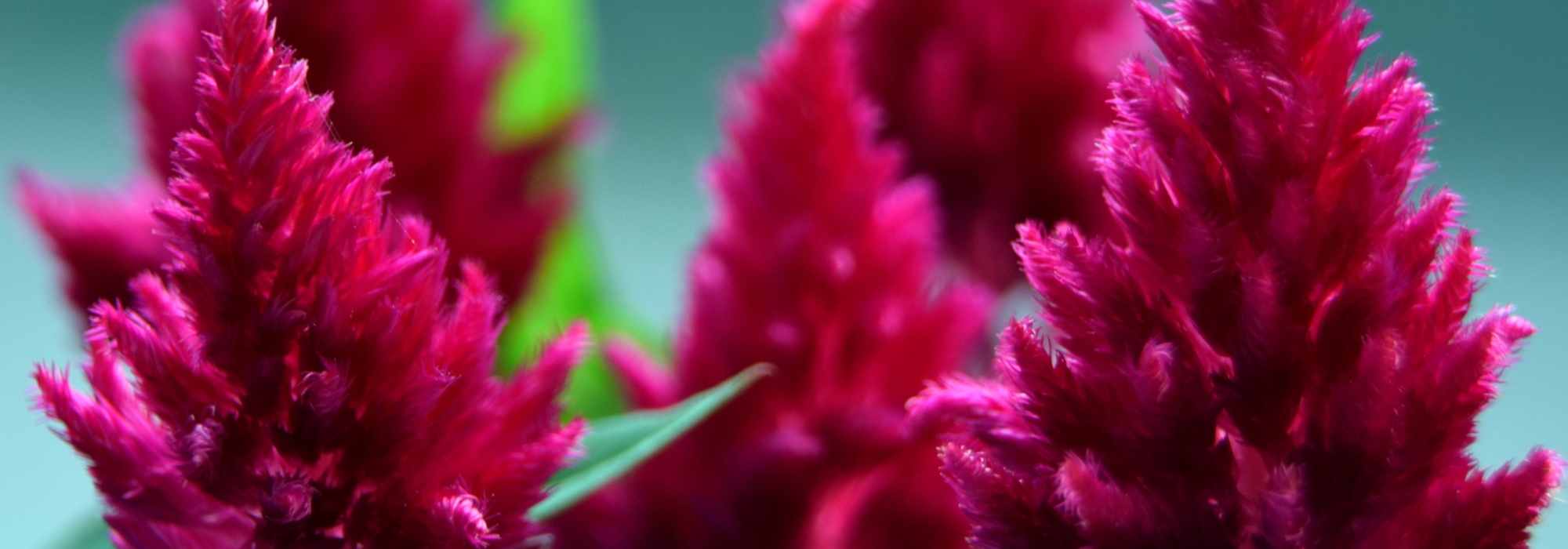
Celosia: sowing, growing and care
Contents
Celosia in a nutshell
- Celosia is an annual plant with a very colourful summer flowering, featuring plumes or cockscombs
- It is an excellent, highly floriferous plant for borders, flower beds, or window boxes
- It is also highly valued in fresh or dried cut flower arrangements
- Easy to maintain, it thrives in full sun and in any rich, cool soil
- It brings originality and colour to the garden all summer long and until the frosts
A word from our expert
Celosia is an annual plant that is particularly floriferous in summer. It is spectacular from June to September-October when it displays its feathery spikes in Celosia argentea plumosa or resembling cockscombs in Celosia cristata. The flowers of celosias boast often flamboyant colours, ranging from deep purple in the Deep Purple® variety to orange in Celosia ‘Kelos Fire Orange’, with all shades of pink and yellow in between.
Reaching nearly 1.20 m or not exceeding 20 cm in height, dressed in eccentric or more subdued colours, there are many species and varieties of Celosia.
This frost-sensitive plant will be grown as an annual flower in our latitudes, either in the ground or in pots. Low-maintenance and undemanding, it thrives in full sun in any well-drained, cool soil.
Outdoors, in borders, flower beds, or pot displays, it will add a lot of originality to the garden. Indoors, it will create spectacular summer bouquets.
Exuberant or subtle, discover our celosias in plug plants or seeds!
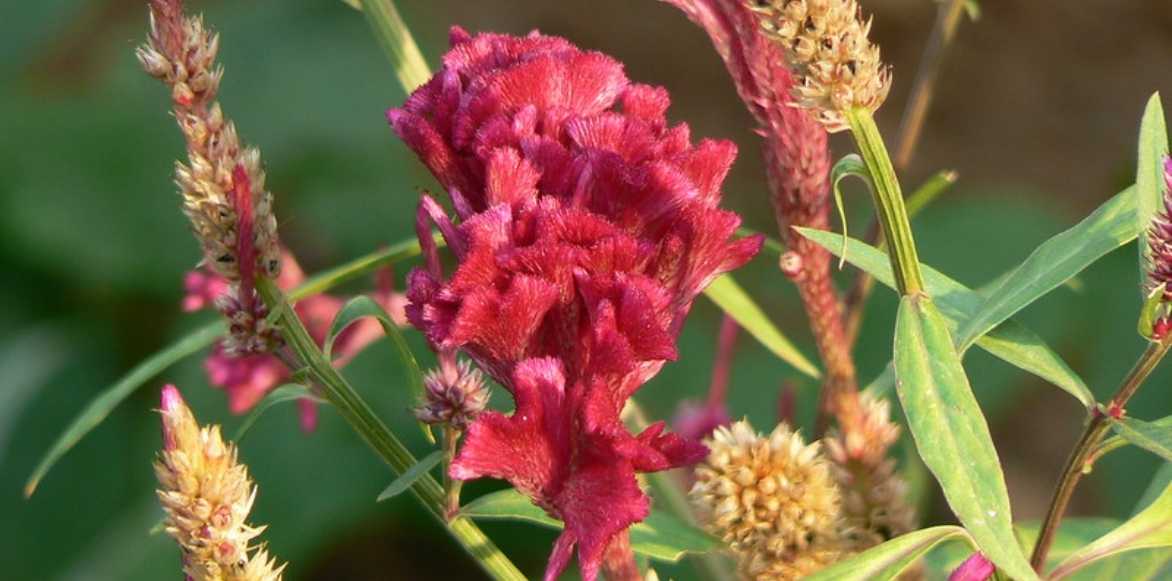
Celosia argentea var cristata (© Dinesh Valke-Flickr)
Botany
Botanical data
- Latin name Celosia
- Family Amaranthaceae
- Common name Cockscomb
- Flowering June to October
- Height 0.20 to 1.20 m
- Exposure Sun, partial shade
- Soil type Rich, cool, well-drained
- Hardiness Frost-sensitive
Cockscomb, also known as ‘Velvet Flower,’ belongs to the Amaranthaceae family, like the flamboyant fox-tail amaranths. The genus comprises around 60 species, including Celosia argentea. In recent years, cockscombs have undergone hybridization, offering an ever-wider choice of colours, flower shapes, and vase life. Thus, three subspecies of Celosia argentea and their numerous varieties can be distinguished:
- The Plumosa group, or feathery cockscombs, featuring Celosia argentea var. plumosa and its many cultivars. They display plume-like inflorescences resembling brightly coloured flames.
- The Cristata group, which showcases curious undulating inflorescences fanned out like a rooster’s comb.
- The Celosia argentea var. spicata group, featuring long, lance-shaped spiky ears pointing skyward.
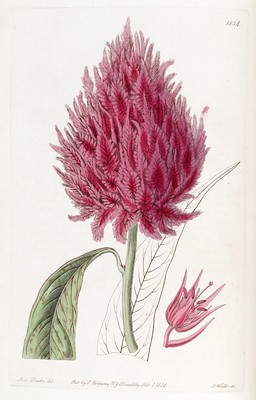
Celosia argentea, botanical plate circa 1830
Native to tropical and temperate regions of America and Africa, this plant is perennial in its native habitat but grown as an annual in our climates. Not hardy in our gardens, it is a frost-sensitive perennial with a short lifespan.
The cockscomb quickly forms an upright, branched clump in 9 to 10 weeks, ranging from just 15 cm in height for the smaller varieties to up to 1.20 m for the taller ones. It displays a deciduous foliage that is somewhat coarse, with deeply marked veins, providing a beautiful backdrop for the flowers. The leaves, measuring 10-15 cm long, are broad, simple, and lanceolate, arranged alternately in clusters along the stems. They exhibit a light green to lime green colour, or even purple-veined green (‘Fire Purple’), depending on the variety. They are edible.
On this bushy vegetation, the stunning flowering, often in saturated colours, occurs in summer, from June to July until the first frosts. The shape of the flowers varies by variety. Celosia Plumosa showcases flower plumes in pyramid-shaped spikes, 10 to 25 cm tall, standing upright at the tips of the stems. Rising above the foliage, they resemble flaming torches. In Celosia cristata, the inflorescences surprise with their crinkled and crisped shapes, evoking combs in early growth, coral, or even a brain viewed from above at full bloom! These undulating or plicate growths measure 8 to 12 cm high and can sometimes reach 20 cm in diameter.
Celosia spicata presents a completely different flowering with long, fine, elegant spikes that can reach 25 cm in height, resembling fluffy wheat ears. This velvety texture has indeed earned cockscombs the nickname “velvet pass.”

Celosia plumosa, Celosia cristata, Celosia spicata
Whether resembling feather dusters, elongated tails, or a large frizzy comb, cockscomb flowers boast an incredible palette of warm colours, astonishing in the plant world, ranging from yellow to orange, burgundy red to Tyrian pink, and intense purple in the cockscomb ‘Fire Purple’, and sometimes even variegated.
The flowering emits a slightly spicy fragrance.
These theatrical inflorescences also make excellent flowers for original bouquets, whether fresh or dried, retaining their colours intact for up to 8 weeks, even when dried. The Celosia argentea var. cristata is the most sought-after for cut flowers.
After flowering, the flowers turn into tiny, shiny seeds that can self-sow.
Used in traditional African medicine, cockscomb possesses medicinal properties, notably haemostatic, astringent, and antibacterial.

Celosia cristata
Read also
10 Easy Annual Flowers to SowMain species and varieties
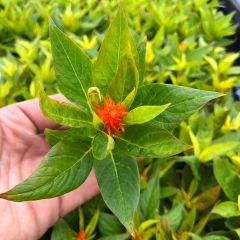
Celosia Kelos Fire Orange - Silver cock's comb
- Flowering time August to October
- Height at maturity 38 cm
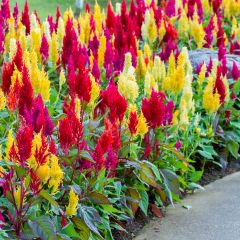
Celosia Pampas Plume Mix Seeds - Chinese Woolflower
- Flowering time August to October
- Height at maturity 1 m
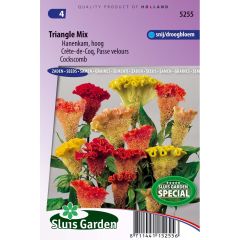
Cockscomb Triangle Mix Seeds - Celosia argentea Cristata
- Flowering time August to November
- Height at maturity 70 cm
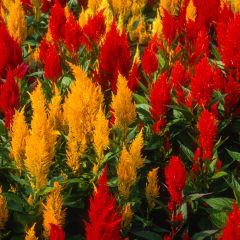
Celosia Fresh Look Red & Yellow - Silver cock's comb
- Flowering time August to October
- Height at maturity 35 cm
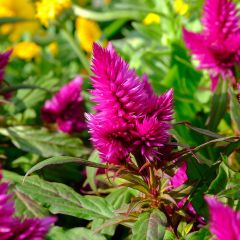
Celosia Kelos Fire Purple - Silver cock's comb
- Flowering time August to October
- Height at maturity 35 cm
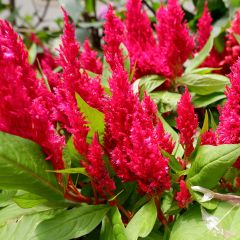
Celosie Kelos Fire Red - Silver cock's comb
- Flowering time August to December
- Height at maturity 38 cm
Discover other Celosias
View all →Available in 0 sizes
Available in 1 sizes
Available in 1 sizes
Available in 1 sizes
Available in 1 sizes
Available in 1 sizes
Available in 1 sizes
Planting and sowing Celosia seeds
Where to plant it?
Celosia is a frost-sensitive perennial, which is why, in our gardens, it is grown as an annual in the ground or in pots. Native to the tropics, it enjoys warmth and sheltered spots away from the wind. Plant it in full sun in well-drained, fertile soil that remains moist.
This annual plant can be grown indoors as well as in the garden.
Large celosias, sometimes imposing (up to 1.20 m in height), will easily fit in the middle of a flower bed or at the back of a perennial or annual border. Other varieties are ideal for brightening up window boxes, pots for a terrace or balcony, or borders.
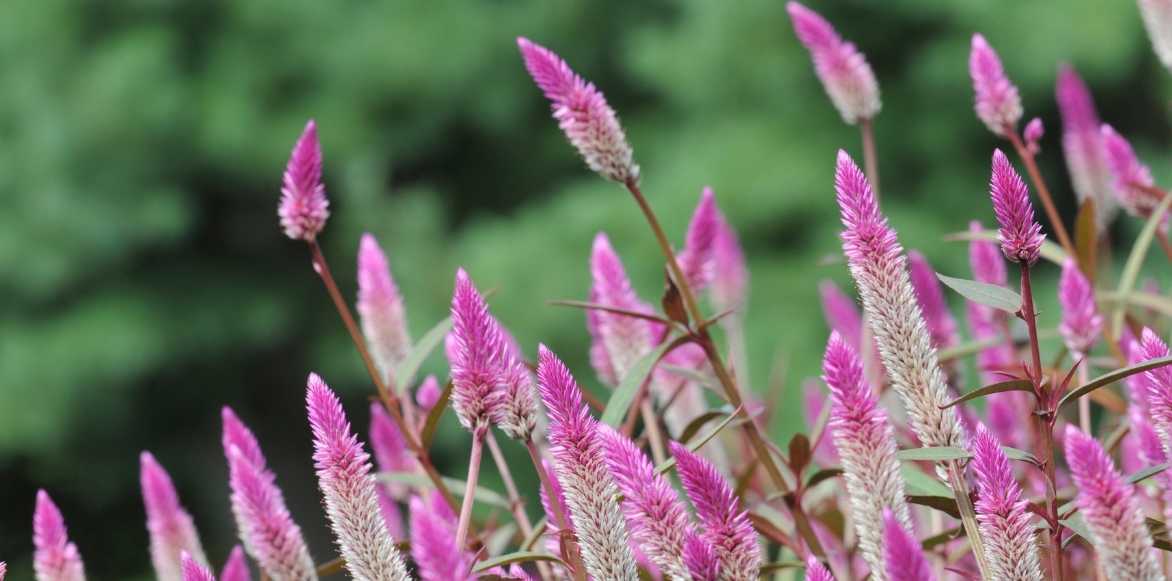
Celosia spicata
When to plant it?
Transplant or plant celosia plug plants in April-May, depending on the region, but in any case after the frost.
How to plant it?
In the ground
For a spectacular effect, plant your celosia plugs in groups of 7 to 9 plants per square metre, spaced 20 to 50 cm apart depending on the variety.
- Prepare the soil well by clearing it of roots and stones
- Plant the plug in a mixture of potting soil and garden soil
- Firm down with the palm of your hand
- Water generously and mulch around the base to retain moisture
Planting Celosia in pots
- Spread a good layer of drainage (clay balls) at the bottom of the pot.
- Transplant your young plant into a mixture of potting soil (special geranium mix, for example) and compost kept moist
- Water very regularly, never allowing the substrate to dry out
→ Learn more in our advice sheet Growing Celosia in Pots. Also discover how to plant our young plug plants.
When and how to sow it?
SowinguUnder cover
Sowing under cover from late February to early March is preferable to sowing directly in the ground, which would result in a flowering that is too late, as the first flowers appear about 3 months after sowing.
- Sow 2 or 3 celosia seeds in pots filled with sifted potting soil
- Lightly cover the seeds with fine potting soil
- Keep your seedlings warm in a bright room at 20°C
- You can also place the pots in a heated mini-greenhouse
- Keep the potting soil moist but not soggy
- Seeds usually germinate in 18 days
- When the seedlings have 4 leaves, pinch them back
- Keep them warm
- Transplant to the garden or pots after all risk of frost has passed and when the soil has warmed to at least 22°C, usually in May
- Add a bit of compost to each planting hole
- Water thoroughly
→ Learn more with our tutorial: How to sow Celosia?
Growing and care of Celosia
Celosia is an easy-to-maintain annual plant, provided the soil remains moist and it is adequately fed. Whether in pots or in the ground, the soil should never dry out, especially during hot periods. Water frequently but in small amounts, avoiding wetting the foliage.
In pots, feed the plant with a fertiliser every 15 days to encourage flowering.
Remove faded flowers as they occur to promote new flower buds. You can allow the plants to go to seed after flowering for future sowing.
To collect celosia seeds: at the end of summer, cut the spikes and let them dry. Once they are thoroughly dry, shake them over a sheet of newspaper to gather the seeds. Store them in a kraft paper bag or an airtight box.
In autumn, pull up the plants from the garden and overwinter the celosias grown in pots away from frost. You can store them at around 10°C in a bright location. Reduce watering and simply keep the substrate slightly moist during winter. Before bringing them out in spring, repot or add a slow-release fertiliser and resume watering.
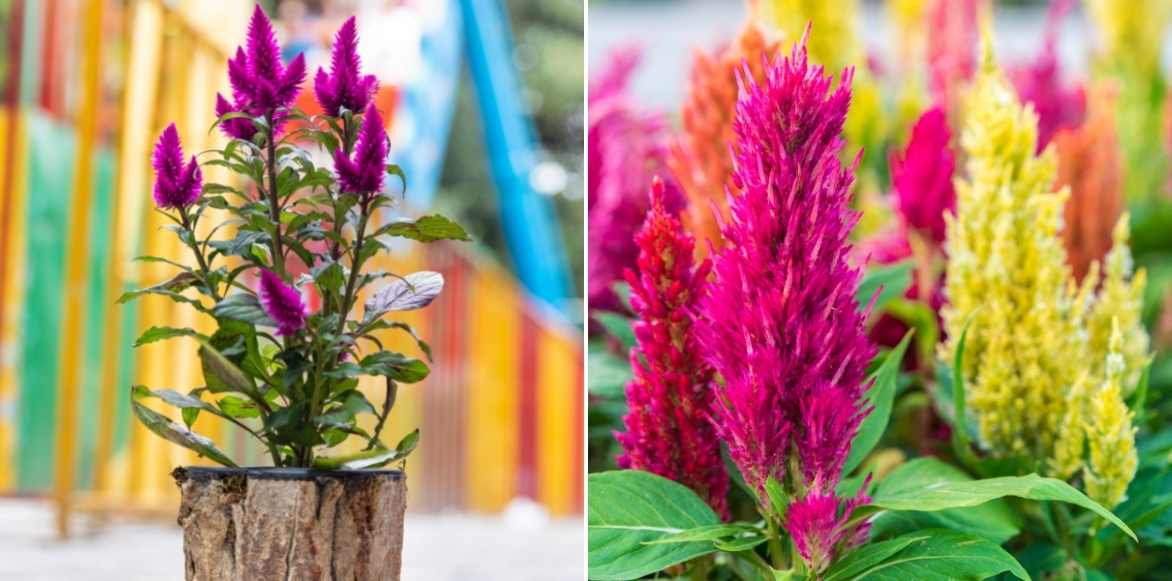
Celosia in pots and in borders
How to dry celosia flowers?
To create dried bouquets, cut the stems and hang them upside down in a well-ventilated room away from sunlight for 1 to 2 months.
Diseases and potential pests
Cockscomb is susceptible to attacks from aphids: plant trap plants nearby to divert them, such as nasturtiums, and regularly spray with soapy water.
Indoors, it can sometimes suffer from invasions of whiteflies or aleurodes, and sometimes also from red spider mites.
Multiplication
Celosia can reproduce by sowing, provided you haven’t cut all the flower spikes and have collected the seeds after flowering.
Pairing ideas
With its spectacular brightly coloured flowering, celosia adds a touch of cheerfulness and originality to the garden. It is always a highly regarded annual, easily integrating into summer displays. It quickly forms a bushy clump, and just a few clumps of celosia are enough to add depth to a simple flower bed or border.
The vivid colours of celosias allow for the creation of long-lasting colourful scenes. To accompany it, choose other brightly coloured annuals such as Amaranths, a Salvia horminum with very original decorative bracts, Marigolds, or even small annual scabious.
The tallest varieties will enhance a beautiful bed with other large annuals such as China asters or Callistephus and Helianthus annuus.
In the heart of an exuberant bed with vibrant tones, celosia keeps company with floriferous perennials such as achilleas, daylilies, echinacea, delphiniums, and gaillardes, as well as annuals such as cosmos, Rudbeckias, and Coleus like ‘Skyfire’.
To avoid a cacophony of strong tones, surround it with plants that have a more subdued appearance, with lighter foliage such as ivy or grasses in straw tones like Pennisetum.
In pots, pair it with petunias, calibrachoas, or dwarf nasturtiums.
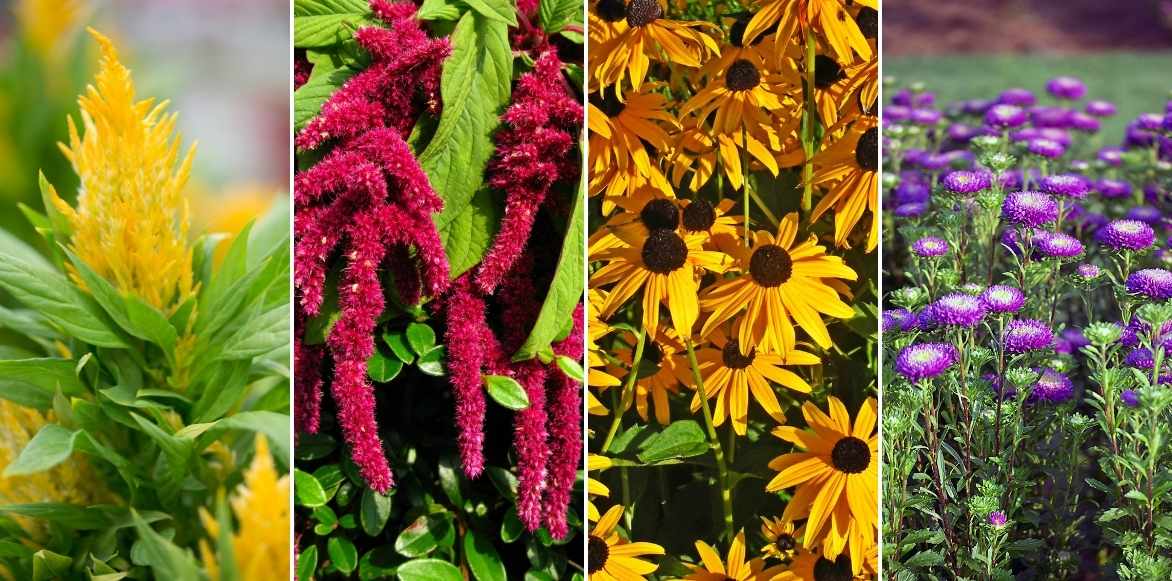
Celosia, Amaranth, Rudbeckias, and China Asters
Did you know?
Cockscomb is considered a vegetable in Latin America where its young leaves are consumed cooked like spinach and its seeds are ground into flour or cooked like quinoa.
Useful resources
- Celosia: an ideal plant for borders and beds
- Discover our tutorial: How to harvest and dry Celosia?
- Never miss your annual seed sowing with our advice sheet
- Check out Christine’s article on feathery inflorescences
- Discover the edible benefit of Celosia with Gwenaëlle on the blog: Celosia: what if we ate it?
- Subscribe!
- Contents































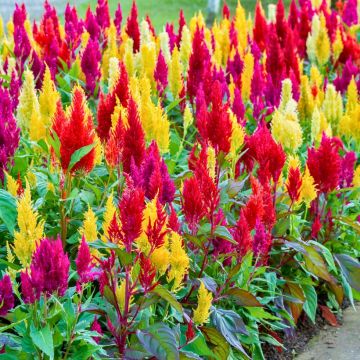

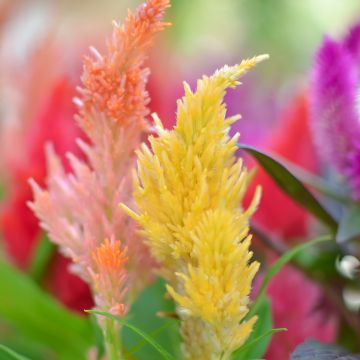

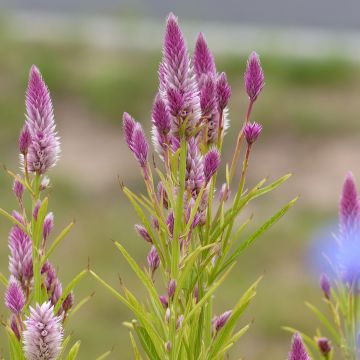
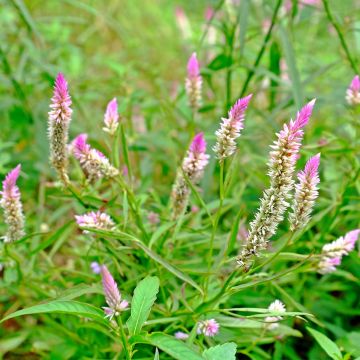

Comments